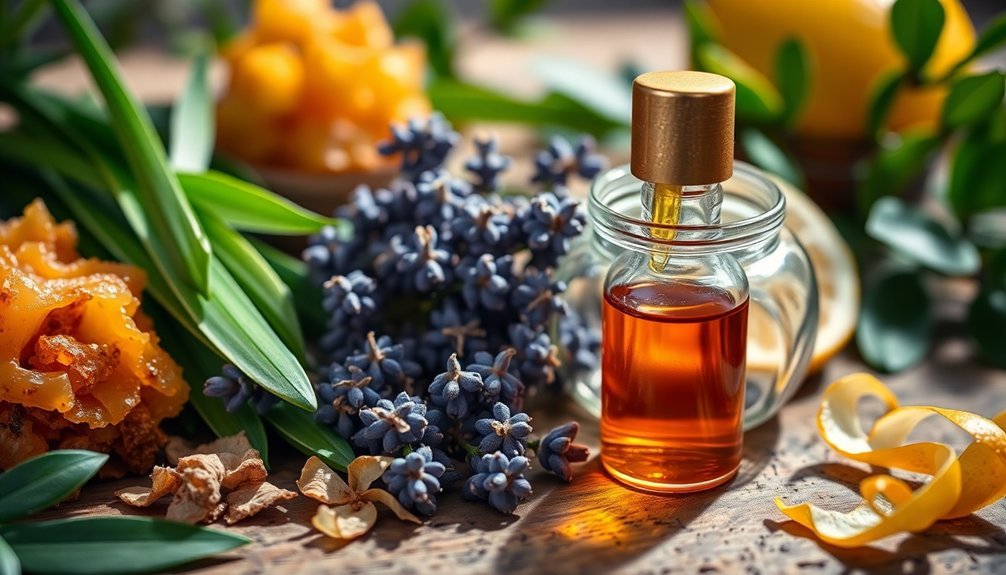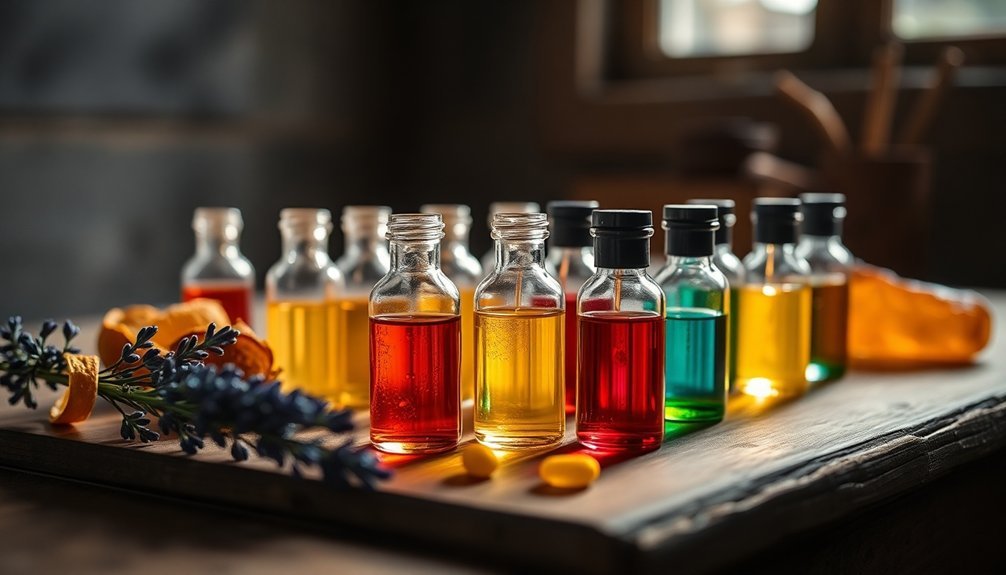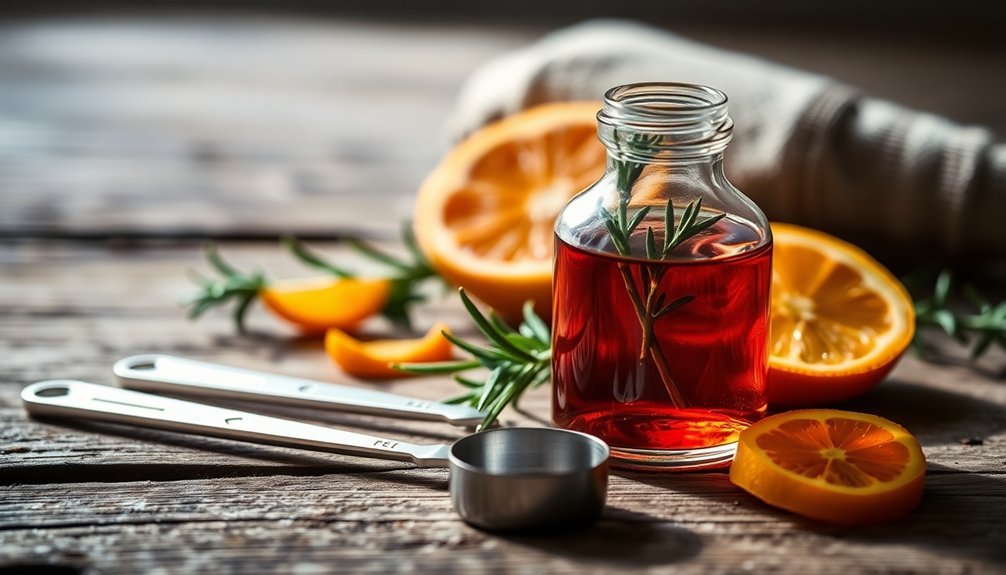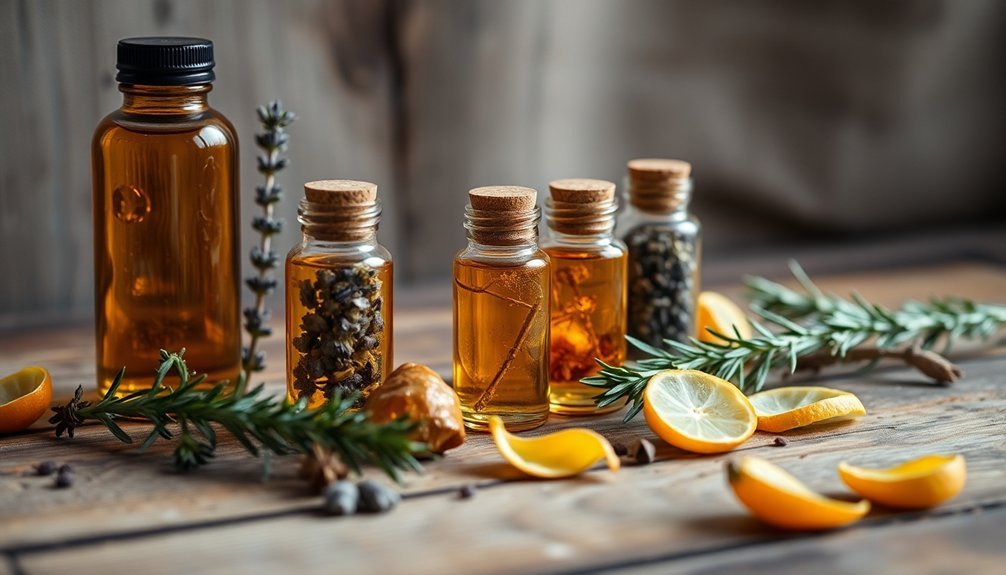Seven powerful fixatives will transform your homemade fragrances into long-lasting masterpieces. Benzoin and labdanum offer classic depth with their resinous warmth, while patchouli and vetiver provide earthy anchoring. For modern options, try Ambroxan, Galaxolide, or Hedione to extend wear time considerably. Add these at 3-5% concentration in your base notes, paired with carrier oils like jojoba or fractionated coconut oil. Master these fixatives, and you'll reveal the secrets to creating fragrances that truly endure.
The Magic of Natural Essential Oil Fixatives

When creating homemade fragrances, natural essential oil fixatives serve as the foundation that transforms fleeting scents into long-lasting perfumes.
These powerful ingredients work by slowing down the evaporation of volatile compounds while stabilizing your fragrance's overall profile.
You'll find that natural fixatives like cedarwood, frankincense, and myrrh do more than just extend your perfume's life – they add remarkable depth and complexity to your creations.
By incorporating these fixatives at a 3-5% concentration in your base notes, you'll anchor the lighter top and middle notes, ensuring they're released gradually throughout the day.
Your skin's chemistry and environmental factors will influence how the fixatives perform, but ingredients like benzoin, labdanum, and sandalwood consistently deliver impressive results in holding your fragrance together. The strategic use of fixatives provides anti-inflammatory properties while enhancing the overall aromatic experience.
Exploring Ancient Resins and Balsams
Throughout history's most sophisticated civilizations, resins and balsams have captivated humans with their intense aromas and fixative properties.
You'll find these precious substances were essential in ancient Egyptian, Greek, and Roman perfumery, where they served both ceremonial and aesthetic purposes.
When you're creating your own fragrances, consider incorporating classic fixatives like benzoin, with its vanilla-like sweetness, or labdanum, known for its deep, leathery character.
You'll want to use these resins at 3-5% concentration in your base notes to effectively trap and slowly release the lighter notes.
These materials work exceptionally well in oriental-style blends, where they'll enhance longevity while adding warmth and depth.
They'll also evolve uniquely with your body chemistry, creating a personalized scent experience that lasts.
Ancient Egyptians utilized these aromatic substances extensively in their embalming processes, demonstrating their remarkable preservative qualities.
Synthetic Fixatives: Modern Solutions for Lasting Scents

You'll find Ambroxan to be a game-changer in your homemade fragrances, as it dramatically extends wear time while adding a subtle amber warmth.
Galaxolide offers your blends exceptional staying power with its clean, fresh musk that won't overpower other notes.
If you're working with florals, Hedione will both fix and elevate these notes, creating an airy, jasmine-like effect that helps your fragrance project beautifully. Starting with these non-aromatic fixatives during formulation ensures optimal performance of your fragrance blend.
Ambroxan's Impact on Longevity
As modern perfumery continues to evolve, Ambroxan has emerged as a revolutionary synthetic fixative that's transforming how fragrances maintain their longevity.
You'll find this stable, synthetic molecule working tirelessly to slow down the evaporation of volatile components while binding other fragrance molecules together.
When you're crafting homemade fragrances, Ambroxan acts as your scent's anchor, grounding volatile top and middle notes while adding complexity to your blend.
You won't have to worry about your fragrance becoming unbalanced or fading quickly, as this powerhouse fixative keeps all elements in perfect harmony.
What's more, its gentle, non-irritating nature makes it ideal for various applications, from perfumes to personal care products, ensuring your creations maintain their intended scent profile throughout the day.
Galaxolide's Clean Lasting Power
Building on the success of Ambroxan, Galaxolide stands out as another remarkable synthetic fixative in modern perfumery. This lab-created musk delivers a clean, sweet scent while effectively extending your fragrance's longevity.
You'll find it particularly useful when you need to balance and stabilize various fragrance components. At concentrations of 3-5% in base notes, Galaxolide works seamlessly with floral, oriental, and woody blends.
It's more cost-effective than natural alternatives like ambergris, while matching the performance of other synthetic musks such as Fixolide. When you're crafting homemade fragrances, you'll appreciate how it enhances both projection and sillage by stabilizing scent molecules.
The result is a more uniform fragrance experience where all notes remain harmoniously balanced throughout wear, making Galaxolide an essential tool in your perfume-making arsenal.
Hedione Lifts Floral Notes
Hedione represents a breakthrough in synthetic fixatives, offering perfumers a powerful tool for elevating floral compositions. You'll find this synthetic jasmine note particularly effective at concentrations between 2-15%, though it can work at levels up to 35%. Its elegant profile combines beautifully with both natural and synthetic ingredients.
| Property | Benefit |
|---|---|
| Fixative Power | Extends fragrance life up to 2 weeks |
| Aroma Profile | Sweet-floral with jasmine and fruit notes |
| Versatility | Works in florals, citrus, and woody blends |
When you're crafting DIY perfumes, Hedione's transparent character will help slow down the evaporation of volatile compounds while adding a delicate, radiant warmth. You can enhance its fixing power by combining it with other fixatives like ambergris or musk ketone to create long-lasting, sophisticated fragrances.
Essential Carrier Oils and Their Fixative Properties
When you're selecting carrier oils for your homemade fragrances, you'll find that fractionated coconut oil and jojoba oil provide excellent longevity with their slow evaporation rates.
You'll want to start with a blend ratio of 30% carrier oil to 70% fragrance oils, adjusting as needed based on your desired strength and staying power.
While common carriers like coconut and jojoba are reliable choices, exploring lesser-known options like meadowfoam seed oil can offer unique benefits, including enhanced oxidative stability and superior moisturizing properties.
Carrier Oil Longevity Benefits
Understanding carrier oils and their fixative properties is essential for creating long-lasting fragrances that maintain their integrity over time. When selecting carrier oils, you'll want to evaluate their stability levels for ideal results.
Saturated oils like coconut oil offer the greatest stability and resistance to oxidation, making them ideal for long-term fragrance preservation.
While monounsaturated oils such as olive oil provide moderate stability, they're still effective carriers for essential oils. However, you'll need to be cautious with polyunsaturated oils, as they're more prone to rancidity.
To maximize your fragrance's longevity, pair your carrier oils with natural fixatives like patchouli, vetiver, or sandalwood essential oils.
These powerful fixatives will anchor your lighter notes while the carrier oils provide a stable base for your fragrance blend.
Blending Ratios For Success
Creating successful fragrance blends requires mastering the delicate balance between carrier oils and fixatives. When working with essential oils like patchouli, vetiver, and sandalwood, you'll want to maintain a ratio of 15-20% fixative oils to your total blend.
For natural resins like labdanum and benzoin, use 5-10% of your formula to anchor the scent effectively.
- Start with a 3:1 ratio of carrier oil to essential oil fixatives
- Use heavier base notes (patchouli, vetiver) at 10-15% of your blend
- Add resinous fixatives (benzoin, myrrh) at 5-10% concentration
- Combine multiple fixatives for enhanced longevity
- Test small batches before scaling up your formula
Mix synthetic fixatives like Ambroxide or Iso E Super at just 1-2% of your total blend for ideal results.
Common Carriers Vs Uncommon
The fundamental difference between common and uncommon carrier oils lies in their availability and potency as natural fixatives.
Common fixatives like patchouli, vetiver, and sandalwood offer reliable stabilizing properties while being readily accessible. These oils excel at anchoring lighter notes and extending fragrance longevity, with patchouli deepening earthy blends and vetiver adding woody depth.
Less common carriers like labdanum, benzoin, and myrrh pack more concentrated fixative power but are harder to source.
You'll find labdanum's leathery notes intensely grounding, while benzoin's vanilla-like qualities provide exceptional staying power.
For unique complexity, consider styrax or the combination of clary sage and orrisroot – they'll not only stabilize your blend but also contribute distinctive aromatic profiles that set your fragrances apart from conventional scents.
Master Blending Ratios for Maximum Longevity

Successful fragrance blending relies heavily on mastering the delicate balance between base, heart, and top notes.
You'll want to start with a 2:1:1 ratio of base, heart, and top notes, adjusting as needed for your desired longevity. For maximum staying power, aim for a total fragrance oil concentration of 20-30%, with base notes comprising 20-40% of your blend.
- Use fixatives like labdanum or benzoin at one-third of your total fragrance oil volume
- Increase your base note concentration for linear perfumes that last longer
- Consider EDP-strength blends with 10-20% fragrance oils for balanced projection
- Incorporate synthetic fixatives like Iso E Super for enhanced staying power
- Adjust ratios based on environmental factors and skin chemistry, as these affect longevity
Natural Vs Synthetic: Choosing the Right Fixative
When choosing fixatives for your homemade fragrance, you'll need to decide between natural and synthetic options, each offering distinct advantages.
Natural fixatives like benzoin and myrrh provide authentic scents while adding depth and warmth to your blend. They're perfect if you're seeking traditional, organic ingredients that contribute their own pleasant aromas to the final fragrance.
Synthetic fixatives such as Ambroxan and Galaxolide offer superior stability and longevity. They're often odorless or neutral-scented, making them ideal when you don't want to alter your fragrance's intended aroma.
While natural fixatives may require larger quantities to achieve desired results, synthetics are typically more concentrated and cost-effective.
Consider your priorities: If you value organic ingredients, go natural; if you're focused on consistency and lasting power, synthetic fixatives might be your better choice.
Best Fixative Combinations for Different Fragrance Families

Understanding fixative combinations can make or break your homemade fragrance success.
For Oriental and Amber scents, pair labdanum with benzoin to create a deep, lasting base.
In floral compositions, combine methyl dihydrojasmonate with small amounts of ambergris for enhanced retention.
Woody fragrances benefit from vetiver and cedarwood's synergistic effect, while musk-based scents achieve ideal longevity when macrocyclic musk meets Iso E Super.
- Oriental: Mix labdanum and benzoin for a rich, enduring foundation
- Floral: Blend methyl dihydrojasmonate (0.01-0.03% ambergris) with tectorigenin
- Woody: Combine vetiver and cedarwood oils with fixolide
- Musk: Layer macrocyclic musk with Iso E Super
- Mixed: Use sandalwood as a universal fixative across families
Frequently Asked Questions
Can Fixatives Change Color or Stain Clothing When Applied to Skin?
While fixatives themselves won't change your skin color, they can stain your clothes if you don't let them dry properly. You'll want to apply them carefully and wait before dressing to avoid any transfer.
How Do Temperature and Humidity Affect the Performance of Different Fixatives?
You'll find that heat weakens fixatives by speeding up evaporation, while cold temperatures enhance their staying power. High humidity helps fixatives lock scents into your skin, but dry conditions reduce their effectiveness.
Are There Any Fixatives That Should Not Be Mixed Together?
You shouldn't mix castoreum with civet, as they'll create an unpleasant clash of animal-like odors. Also avoid combining Fixative BMV with alcohol-based fixatives due to solubility issues.
Do Fixatives Have Different Shelf Lives Than Regular Fragrance Ingredients?
Yes, your fixatives' shelf lives will vary considerably. Natural fixatives typically last 1-2 years, while synthetic ones can remain stable for up to 5 years. They'll generally outlast most top and middle notes.
Can Fixatives Cause Allergic Reactions in Sensitive Individuals?
Yes, you'll need to be careful with fixatives as they can trigger allergic reactions. Even natural ones like benzoin and myrrh might cause redness, itching, or dermatitis. It's wise to patch test first.
In Summary
Whether you're creating floral, woody, or oriental blends, you'll find the perfect fixative combination to make your signature scent last. Don't be afraid to experiment with both natural and synthetic options – from precious resins to modern molecules. Start with small batches, test different ratios, and you'll soon master the art of extending your fragrance's longevity while maintaining its intended character.





Leave a Reply